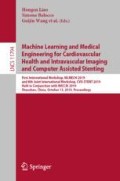Abstract
Disease prediction based on modeling the correlations between compounded indicator factors is a widely used technique in high incidence chronic disease prevention diagnosis. Predictive models based on personal health information have been developed historically by using simple regression fitting over relatively few factors. Regression approaches have been favored in previous prediction modeling approaches because they are simplest and do not assume any non-linearity in the model for contributions of the chosen factors. In practice, many factors are correlated and have underlying non-linear relationships to the predicted outcome. Deep learning offers a means to construct a more complex modeling approach, along with automation and adaptation. The aim of this paper is to assess the ability of a deep learning model to predict the heart disease incidence using a common benchmark dataset (University of California, Irvine (UCI) dataset). The performance of deep learning model has been compared with four popular machine learning models (two linear and two nonlinear) in predicting the incidence of heart disease using data from 567 participants from two cohorts taken from UCI database. The deep learning model was able to achieve the best accuracy of 94% and an AUC score of 0.964 when compared to other models. The performance of deep learning and nonlinear machine learning models was significantly better compared to the linear machine learning models with increase in the dataset size.
This research was funded by the Government of South Australia and Shandong Provincial Government, China.
Access this chapter
Tax calculation will be finalised at checkout
Purchases are for personal use only
References
AIHW: Cardiovascular disease: Australian facts 2011. Cardiovascular disease series. Cat. no. CVD 53. Canberra. Australian Institute of Health and Welfare (2011)
Bache, K., Lichman, M.: UCI Machine Learning Repository Irvine. University of California, School of Information and Computer Science, Oakland (2013). http://archive.ics.uci.edu/ml
Breiman, L.: Random forests. Mach. Learn. 45(1), 5–32 (2001)
D’Agostino, R.B., et al.: General cardiovascular risk profile for use in primary care. Circulation 117(6), 743–753 (2008)
Goff, D.C., et al.: 2013 ACC/AHA guideline on the assessment of cardiovascular risk: a report of the American College of Cardiology/American Heart Association task force on practice guidelines. J. Am. Coll. Cardiol. 63(25 Part B), 2935–2959 (2014)
Goldstein, B.A., Navar, A.M., Carter, R.E.: Moving beyond regression techniques in cardiovascular risk prediction: applying machine learning to address analytic challenges. Eur. Heart J. 38(23), 1805–1814 (2016)
Goodfellow, I., Bengio, Y., Courville, A.: Deep Learning. MIT Press, Cambridge (2016)
Hlatky, M.A., et al.: Criteria for evaluation of novel markers of cardiovascular risk: a scientific statement from the American Heart Association. Circulation 119(17), 2408–2416 (2009)
Hosmer Jr., D.W., Lemeshow, S., Sturdivant, R.X.: Applied Logistic Regression, vol. 398. Wiley, Hoboken (2013)
Mika, S., Ratsch, G., Weston, J., Scholkopf, B., Mullers, K.R.: Fisher discriminant analysis with kernels. In: Neural Networks for Signal Processing IX: Proceedings of the 1999 IEEE Signal Processing Society Workshop (Cat. No. 98th8468), pp. 41–48. IEEE (1999)
Sajeev, S., Maeder, A.: Cardiovascular risk prediction models: a scoping review. In: Proceedings of the Australasian Computer Science Week Multiconference, p. 21. ACM (2019)
Van Gestel, T., et al.: Benchmarking least squares support vector machine classifiers. Mach. Learn. 54(1), 5–32 (2004)
Weng, S.F., Reps, J., Kai, J., Garibaldi, J.M., Qureshi, N.: Can machine-learning improve cardiovascular risk prediction using routine clinical data? PLoS ONE 12(4), e0174944 (2017)
WHO: Prevention of cardiovascular disease : guidelines for assessment and management of total cardiovascular risk. World Health Organization (2007)
Author information
Authors and Affiliations
Corresponding author
Editor information
Editors and Affiliations
Rights and permissions
Copyright information
© 2019 Springer Nature Switzerland AG
About this paper
Cite this paper
Sajeev, S. et al. (2019). Deep Learning to Improve Heart Disease Risk Prediction. In: Liao, H., et al. Machine Learning and Medical Engineering for Cardiovascular Health and Intravascular Imaging and Computer Assisted Stenting. MLMECH CVII-STENT 2019 2019. Lecture Notes in Computer Science(), vol 11794. Springer, Cham. https://doi.org/10.1007/978-3-030-33327-0_12
Download citation
DOI: https://doi.org/10.1007/978-3-030-33327-0_12
Published:
Publisher Name: Springer, Cham
Print ISBN: 978-3-030-33326-3
Online ISBN: 978-3-030-33327-0
eBook Packages: Computer ScienceComputer Science (R0)


